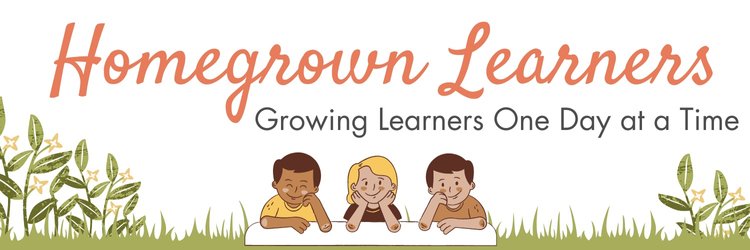I am so thankful we have chosen Classical Conversations.
Our current year in CC has been so sweet for our family. I know that we will look back on this year with many fond memories and stories of God's faithfulness.
After being in an established community for three years, this year I have the great joy of helping a dear friend of mine start a new community. And (here's the exciting part) after observing my son's tutors for three years, I am now doing the tutoring myself!
I spend each Tuesday morning with 7 precious Abecedarians, and we have SUCH FUN!
You can learn so much being on the other side in a community. Tutoring not only helps me teach my own child more effectively, but it also gives me greater insight into the Classical model. (It took me a while to realize the memory work was enough!)
As a Foundations tutor, I am finding the job of modeling a "stick in the sand" approach for the parents in my classroom to be of the utmost importance. I actually do them a DISSERVICE if I stray from simplicity in Foundations.
I've discovered a few simple tips that have made my life abundantly easier - and ultimately make the class experience more effective for students and parents.
(If you have a tendency to go overboard - make elaborate games - spend hours on your board - plan "extra" activities to enhance the memory work - this post is for YOU! And really, it's for me, too.)
“When teaching my own boys or when tutoring CC students, I always ask myself this question: If I only had a stick and sand, could I engage and effectively dialogue with my students about the concept I want to teach them? Asking this question helps us to rely more on modeling, dialogue, and relationship than on the false sense of accomplishment a flashy presentation can leave.”
Hand Write Your Board
CC Connected is full of beautiful resources for you to print and use AT HOME.
During community day, however, the tri fold board should be simple - stick in the sand - and it shouldn't take you hours to prepare.
There is one part of the board, however, I always print, and that is the geography memory work. I find that a quality color map helps when we are labeling our maps in class.
I print the maps from user trvaron on CC Connected to use on the tri fold board.
Everything on the board is also in the same place each week. My little ones need the predictability of Latin always being in the upper left, English Grammar being in the upper right, etc...
And of course - GOD is always at the center of it all.
Keep the Schedule Consistent
Again, so much goes back to consistency.
We have the same schedule every Tuesday morning. It looks roughly (because of course we need to be flexible sometimes) like this:
- 9:00-9:30 - opening assembly
- 9:30-10:00 - introduction of new grammar
- 10:00-10:30 - snack and presentation
- 10:30-11:00 - fine arts
- 11:00-11:30 - science (usually involves being outside if we can swing it)
- 11:30-12:00 - review
This consistency lets my students feel like they have control over their time and they function so much better when they know what is coming next.
My little guys love routine so much that they picked up on the fact that we always do a little "get your wiggles out" activity right before science each Tuesday. Last week I forgot - and someone said "Hey - we didn't get our wiggles out!"
Again, keep the routine simple and predictable. It means less planning for you and more enjoyment and better behavior for everyone else.
Choose a Few Fun Extras
Notice I say "a few" - because my tendency has normally been to go a bit overboard. (I am a recovering public school teacher, after all!) You shouldn't have to spend a lot of time or effort to pull off a fun Foundations class.
My tutor bag of tricks contains just a few fun props that we use in pretty much the same way each class session.
Among our favorites:
- Leo the Latin Lion - This puppet only comes out during Latin. He's oh so precocious and loves to kiss pretty girls on the cheek, nibble their hair, and be silly while he is holding the pointer in his mouth. Often times children will feel more comfortable with the puppet than they will on their own. We love Leo!
- Shaky Eggs - these are great for all of the chants, songs, and anything else that has rhythm. You would be amazed what good behavior the children will have just to have a chance with these little maracas.
- Sweet Swats - These extendable fly swatters are perfect for swatting the English Grammar memory work. They've been particularly helpful with all of the pronouns we have to memorize. I put each pronoun on a sheet of paper, and then a child swats each one as we say them - usually with a fun rhythm.
- Big Foam Dice - There are a million uses for these big dice. We use them to play a simple review game at the end of class.
- Hand Pointer - You really cannot live without one of these!
- Voice Cube - I found a template on CC Connected and glued the different voices to one of the big foam dice. The kids LOVE this.
- Crown - There are so many history sentences that deal with kings and queens. A good crown will serve you well in acting out history memory work, and just for being silly in general.
- Nerf Suction Dart Gun - awesome for review time - and it certainly will get used in your home, too!
Know Some Discipline Tricks
While it isn't the tutor's job to "discipline" the children, it certainly helps when the tutor sets the students up for behavioral success.
In my many years of classroom teaching I did learn quite a few positive discipline techniques. So much of a successful community morning depends on positive reinforcement and creative discipline.
Some ideas:
- Have a few snappy "call-backs" - by this I mean something YOU say, and then the students respond with something else. Or, just something catchy that you say to get the children's attention. For example:
Teacher: "Macaroni and Cheese"
Students: "Everybody Freeze!"
Teacher: "Eyes on the Ceiling. Eyes on the Floor. Eyes on the Ceiling. Eyes on the Door. Eyes on Miss ___________________."
Teacher: "1, 2, 3"
Students: "Eyes on Me!"
You can also Google "Classroom Callbacks" to come up with other clever ideas.
- Positive Reinforcement - Simply noticing when a student is doing something well goes such a long way.
"Mary, I love the way you are sitting quietly and waiting for instructions. That is AWESOME!"
"Johnny, thank you so much for listening. You may be our next pointer."
- Proximity - Often times you don't need to SAY anything to get a desired behavior from a child. A simple hand on the shoulder or standing next to a student will send the message that you are watching their behavior.
You will soon discover which students this works well for, and which students it might not work for.
- Use Your Parents! - The parents are in the Foundations classroom to assist YOU. Have a parent sit between two children who might need some redirection. Communicate to the parents in the room that they are FREE to ask a child to be quiet or help them make the right decision. Don't be afraid to take advantage of your greatest resource in the room - other parents!
Plan Extra - Just in Case!
There are some days with my Abecedarians that there simply isn't ENOUGH time to get in 30 minutes of review at the end.
Then, there are other days when science, presentation, or fine arts hasn't taken up the full 30 minutes of time.
The worst thing to happen is to be stuck with dead time and NOTHING to do. (Ask me how I know.)
It's a good thing to have a tutor bag of tricks that you can pull from when you need that extra something. These things have saved me on many occasions:
- Geography Blob Maps - Our children can never have too much practice with mapping the world. Put blob maps in page protectors and let them trace - then turn on the other side and ask them to draw from memory.
- Sidewalk Chalk - You can always take your kids outside and skip count the times tables on the pavement! Or, you can write English memory work and hop on pronouns. The possibilities are endless on a sunny day.
- Inflatable Globe - You can throw the globe from child to child and identify geography memory work along the way.
- Classical Music - Use some of the musical selections for the cycle you are in. Load them onto your phone and if things get a little out of control, or if you just need some quiet time at the end of class, pass out those white boards - let your children draw while listening to music they will be hearing (or have heard) during that cycle. Or, you can turn off the lights, play that music and just have some quiet time to form a picture in their heads. You will be AMAZED at how much children enjoy this.
- Books - I always try to keep a stash of seasonal books in my tutor bin - or books that go along with our science, history, or fine arts. I could give you a huge list, but I'll just list a few favorites.
Remember, your students don't want flashy and shiny. They don't want you to spend hours of your time preparing for community day.
What they truly crave is order, discipline, and a tutor who is well grounded in the Classical model.
Keep it simple and bear a few simple tips in mind and you will have a GREAT year!
Are you a CC Foundations tutor? Do you have any additional tips to share?














